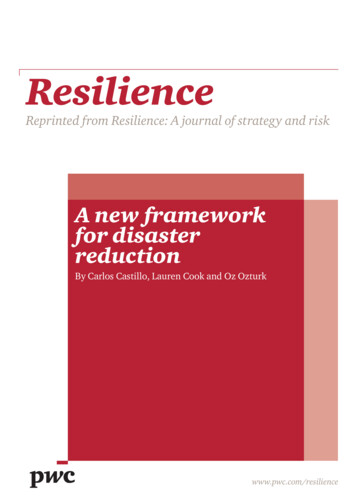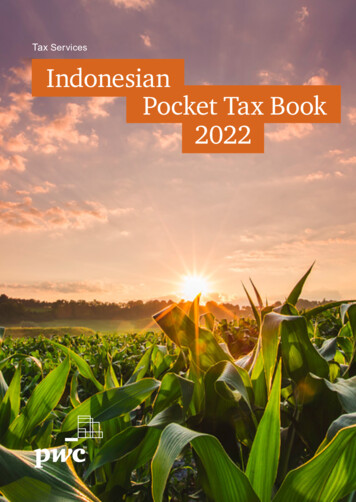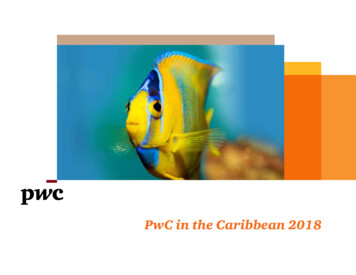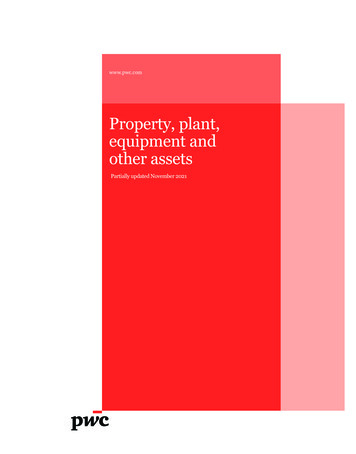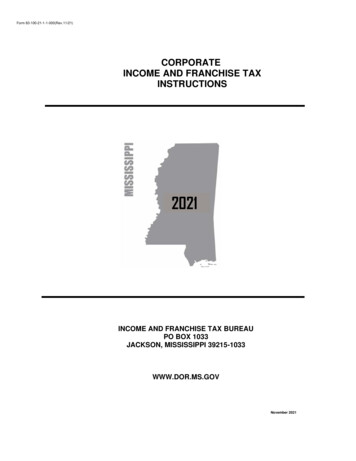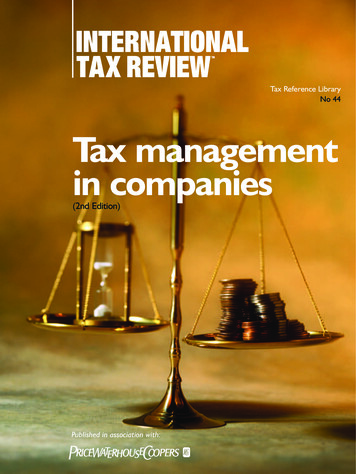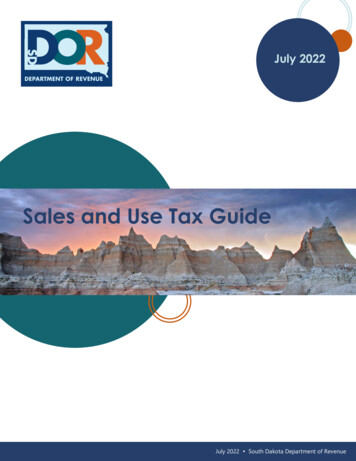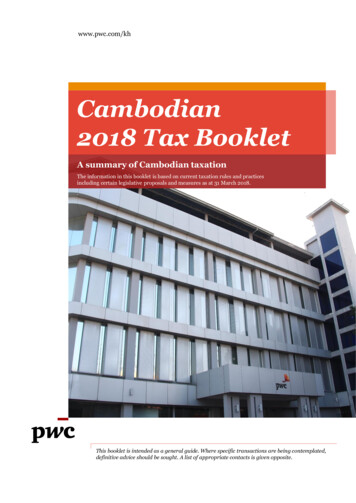
Transcription
www.pwc.com/khCambodian2018 Tax BookletA summary of Cambodian taxationThe information in this booklet is based on current taxation rules and practicesincluding certain legislative proposals and measures as at 31 March 2018.This booklet is intended as a general guide. Where specific transactions are being contemplated,definitive advice should be sought. A list of appropriate contacts is given opposite.
Table of contents1 Taxation-General overviewCambodian tax system2 Corporate Income Tax-15Import dutiesInvestment incentivesExport duties9 Tax on Salary-14General overviewTax ratesTax baseAdministration8 Import and Export Duties-12General overviewScope of applicationExempt goods and servicesTax ratesTax baseRegistrationAdministration7 Specific tax on certain merchandise and services-11Scope of withholding taxesDeductibility of withholding taxes6 Value Added Tax (VAT)-10General overviewAdministration5 Withholding Taxes-9Dividend distribution4 Minimum Tax-5Scope of taxationResidency and source of incomeTax ratesPrepaymentsTax holidaysCalculation of taxable incomeDeductible and non-deductible rulesSpecial depreciationLosses carried forwardTransfer pricingAdministration3 Additional Tax on Dividend Distribution (ATDD)-4General overviewResidencyTaxable salaryDeductionsTax ratesAdministration16
Table of contents10 Other taxes-18Public lighting taxAccommodation taxTax on immovable propertyTax on unused landStamp taxTax stampsPatent taxTax on means of transportation11 Double taxation agreements12 Investment and tax incentives13 Statutory audit requirements14 Cambodian Stock Exchange2021222315 Cambodia International Financial Reporting Standards 24
1TaxationGeneral overviewMost business activities and investments in Cambodia will be affected by the following taxes: Corporate income tax Minimum tax Withholding tax Value added tax Import duties Tax on salary of employees.There are various other taxes that may affect certain activities in specific industries, including: Accommodation tax Specific tax on certain merchandise and services (excise tax) Public lighting tax Other taxesCambodian tax systemCambodia’s tax system is a self-declaration regime. The estimated and simplified regimes wereeliminated in 2016, and the term ‘real regime’ has been replaced by the term ‘self-declarationregime’. Taxpayers under the self-declaration regime are classified into three categories: small taxpayers medium taxpayers large taxpayersForeign companies, branches and representative offices registered with the Ministry of Commerce(MoC) and the General Department of Taxation (GDT) are generally under the self-declarationregime.Small local and family businesses whose annual turnover is below KHR250 million (approximatelyUSD62,500) are exempt from tax obligations and liabilities.Currently, Cambodia does not have a comprehensive personal income tax system that requiresindividuals to file and pay tax to the GDT directly.Cambodia Tax Booklet 20184
2Corporate Income Tax (CIT)Scope of taxationAll foreign companies registered in Cambodia are under the self-declaration regime. Unlessotherwise noted, the content of this publication applies only to self-declaration regime taxpayers.Residency and source of incomeResident taxpayers are subject to tax on their worldwide income while non-residents are taxed onCambodian-sourced income only. Residents earning foreign-sourced income can receive credits forforeign taxes paid, as Cambodia unilaterally accepts foreign tax credits.Resident taxpayers include companies organised, managed or having their principal place ofbusiness in Cambodia. A non-Cambodian national will become a resident if they have their residenceor principal place of abode in Cambodia, or are present in Cambodia for more than 182 days in any12-month period ending in the current tax year.A permanent establishment (PE) is subject to tax on its Cambodian-sourced income only.Tax ratesStandard rate20%Oil and gas, and certain mineral exploitation activities30%General risk (non-life) insurance activities5% (on gross premium income)Resident individuals0% to 20%Tax exemption (tax holiday)0%PrepaymentsA monthly prepayment of CIT, equal to 1% of monthly turnover including all taxes except VAT, mustbe paid by the 20th day of the following month. The prepayment of CIT can be offset against theannual CIT liability or the minimum tax liability. If the prepayment of CIT exceeds the annual CITliability or minimum tax liability, the excess prepayment of CIT can be carried forward indefinitely tooffset against a future CIT liability.If a taxpayer is not subject to minimum tax (see page 10), monthly Prepayment of CIT must still bemade. But unused prepayments of CIT from prior years can be offset against the prepayment of CITdue in the current tax year and there may not be any physical payment required.A company that has been granted a tax holiday, and is therefore subject to 0% CIT is not required topay prepayment of CIT on turnover derived from the project that has been granted tax incentives.But the entity must still prepare the CIT return and submit it to the tax authority.Tax holidaysA Qualified Investment Project (QIP), being a project recognised and registered with the Council forDevelopment of Cambodia (CDC) will be entitled to a tax holiday. The tax holiday period iscomposed of a trigger period 3 priority period.The trigger period starts on the date the Final Registration Certificate is issued by the CDC and endson the last day of the taxation year immediately preceding the earlier of:-If the QIP derives a profit: the taxation year that the profit is first derived; or-If the QIP derives income from the investment activity, the third taxation year after the taxationyear in which the income is first derived.Cambodia Tax Booklet 20185
2Corporate Income TaxThe priority period is determined by the CDC based on the industry, investment capital and otherfactors.Calculation of taxable incomeTaxable income is essentially the difference between total taxable revenue, whether from a domesticor foreign source, and deductible expenses incurred to carry on the business, plus other passiveincome such as interest, royalties and rent.Taxpayers must prepare an annual CIT return which includes a section for making adjustments toaccounting profit to arrive at the taxable profit and tax payable.Deductible and non-deductible ruleExpenses are tax-deductible if they are paid or incurred during the tax year to carry on business.Expenses must be supported by valid documentation.Specific deductibility provisions apply to the following expenses:a. Designated payments to company officers, directors, etc.: Deductible to the extent that thepayments are reasonable.b. Plant and building related interest and taxes: Interest and taxes incurred during the constructionor acquisition phase must be capitalised and depreciated with the relevant property.c. Interest expenses not falling into (b above): Deductible up to the total interest income plus 50%of net non-interest income. Any interest expense exceeding this limit may be carried forward tothe following year’s calculation. The interest rate on loans may be between 0% and the maximuminterest rate determined by the GDT each year. Interest expenses that exceed the maximumannual rate are permanently non-deductible. The maximum interest rate allowed for taxdeduction purposes is:o 120% of the annual interest rate for loans from a third party, oro 100% of the annual interest rate for loans from a related party.d. Tangible property: Depreciable using the applicable rates and methods below.AssetRateMethod- Buildings and structures5%Straight line50%Declining balance25%Declining balance20%Declining balance- Computers, electronic information systems,software and data handling equipment- Automobiles, trucks, office furnitureand equipment- All other tangible propertye.Intangible property: Depreciable over the useful life or at 10% using the straight-line method.f.Exploration and development costs: Amortisable with reference to the exploitation of therelevant natural resource.g.Charitable contributions: Deductible up to a maximum of 5% of taxable income provided thatadequate evidence is available.h.Amusement, recreation or entertainment: Non-deductible.i.Personal expenses not subject to tax on salary or tax on fringe benefits: Non-deductible.j.Income tax, including tax paid on another’s behalf: Non-deductible.k.Withholding tax, tax on salary and tax on fringe benefits borne by a payer or employer on behalfof suppliers or employees: Non-deductible.l.Accrued expenses: Deductible if they meet stipulated conditions.m. Loss on any sale or exchange of property, directly or indirectly, between related parties: Nondeductible.Cambodia Tax Booklet 20186
2Corporate Income TaxSpecial depreciationA QIP is entitled to 40% special depreciation of assets in the first year of purchase or the first yearthe assets are used. Special depreciation only applies to assets used in ‘manufacturing andprocessing’ (not defined) and only if the taxpayer has elected not to use a tax holiday. A claw-backprovision exists for assets held for less than four years.Losses carried forwardTaxpayers may carry forward losses for five years. The carry-back of losses is not permitted. There isno provision for any consolidated filing or group loss relief.To be eligible to carry forward tax losses, a taxpayer must have proof of the loss, such as accountingrecords and tax returns that were filed on time, and must not have changed its business activities orownership.If a taxpayer receives a unilateral tax reassessment from the GDT, the taxpayer will not be able toutilise the tax losses brought forward in the year of tax reassessment.Transfer pricingOn 10 October 2017, the Cambodian Ministry of Economy and Finance issued the Prakas No. 986MEF.Prk. to provide ‘rules and procedures on income and expense allocation among related parties’(known as the ‘Local Transfer Pricing (TP) Rules’), which is effective immediately. The TP rulesrepresent one of the most important developments in the Cambodian tax regulations aiming toimprove tax transparency and combatting tax avoidance.Related party definitionThe local TP rules define ‘related party’ as a relative of a taxpayer or an enterprise that controls, iscontrolled by, or is under common control with the taxpayer. The term ‘control’ means ownership of20% or more of the equity interest in the enterprise or voting power in the board of directors.Transfer pricing methodologiesThe acceptable transfer pricing methods for determining the arm’s length price under the local TPrules are those endorsed by the Organisation for Economic Co-operation and Development (OECD)in the Transfer Pricing Guidelines for Multinational Enterprises and Tax Administrations, i.e.comparable uncontrolled price, resale price, cost plus, transactional net margin, and profit splitmethods.Transfer pricing documentationEntities which transact with related parties must prepare and maintain transfer pricingdocumentation setting out related-party transactions and the transfer pricing methodologies used tojustify an arm’s length value. Based on the local TP rules, contents of information required in the TPdocumentation is more detailed than those listed in the OECD guidelines. Documents related to thetransactions including invoices must also be kept for a period of ten years from the tax year end.Entities must also declare information of related-party transactions when filing their annualcorporate income tax return and provide relevant transfer pricing documents if required by the taxauthority.Cambodia Tax Booklet 20187
2Corporate Income TaxPenalty for non-complianceThe direct consequence for non-compliance with the TP requirements includes a withdrawal of taxcompliance certificate if the taxpayer has obtained one. The taxpayer shall be penalised inaccordance with Article 133 of the Law on Taxation (for obstructing the implementation of the taxlaw). The tax administration might also take legal action to seek prosecution for criminal violationsof tax provisions as stated in Articles 134-138 of the Law on Taxation (a fine from USD1,250 toUSD5,000 and imprisonment from 1 year to 5 years).The most important risk is that the tax authorities make a TP adjustment, which could result insignificant changes in the taxable income or non-deductible expenses. This could result insignificant underpayment of taxes. Penalties up to 40% and interest charge of 2% per month(without cap) will be imposed on any underpaid taxes. Generally, the tax authorities will also assessindirect taxes such as VAT or other excise taxes if the TP adjustment is made.AdministrationCIT returns must be filed annually within three months of the tax year end. The standard tax year isthe calendar year, although different tax year-ends may be granted on application.The CIT liability can be offset by the unused prepayment of CIT and other withholding tax credits.Cambodia Tax Booklet 20188
3Additional Tax on Dividend Distribution (ATDD)Dividend distributionThe distribution of dividends is subject to additional CIT on dividend distribution as follows:If the dividend is already subject to CIT rate:ATDD rate:0%20% or 30%20%Nil30%NilInterim dividends that have not been subject to CIT are subject to ATDD at a standard rate of 20% or30%.Cambodia Tax Booklet 20189
4Minimum TaxGeneral overviewSelf-declaration regime taxpayers are subject to minimum tax. Minimum tax is an annual tax that isequal to 1% of annual turnover (not defined) including all taxes except VAT. From 1 January 2017,only taxpayers that do not maintain proper accounting records are subject to minimum tax. Thecriteria for determining whether a taxpayer has maintained proper accounting records is broadlydefined in a Prakas. QIPs are no longer automatically exempt from minimum tax and will be subjectto the same condition (i.e. maintaining proper accounting records) to be entitled to minimum taxexemption.Minimum tax is due if the minimum tax liability (1% of the total annual turnover) exceeds the CITliability (20% of taxable profit). This tax is irrespective of whether the taxpayer is in an income orloss position.AdministrationThe minimum tax deadline is the same as the annual CIT deadline, which is three months after thetax year end.The minimum tax liability can be offset by the unused prepayment of CIT and withholding taxcredits.Cambodia Tax Booklet 201810
5Withholding TaxesScope of withholding taxesWithholding Tax (WHT) needs to be withheld on certain payments (in cash or in kind) made byresidents. In practice, only self-declaration regime taxpayers are required to withhold tax. Thewithheld tax constitutes a final tax.The following types of payments are subject to withholding tax:Payments to residents Rental: 10% Services: 15% (except payments to a registered taxpayer supported by proper tax invoices) Royalties: 15% Interest: 15% (except payments to a bank in Cambodia) Interest on fixed-term deposits: 6% (for payments from a bank in Cambodia only) Interest on non-fixed term savings deposits: 4% (for payments from a bank in Cambodia only)Payments to non-residentsA resident taxpayer including permanent establishment making payment of Cambodian-sourcedincome to a non-resident is required to withhold 14% WHT . This withholding tax does not apply topayment of premium for reinsurance of property or other risks in Cambodia.Withholding tax is due when the expense is paid. An expense is considered paid when it is recordedin the accounting records as an expense or when it is physically paid. Withholding tax must beremitted by the 20th day of the following month.Deductibility of withholding taxesIf a taxpayer fails to withhold taxes from suppliers or employees, the taxpayer is not allowed to grossup the base to calculate those taxes. Any withholding taxes borne by the taxpayer are not deductiblefor CIT purposes.Cambodia Tax Booklet 201811
6Value Added Tax (VAT)General overviewUnder the VAT system, output tax is collected from the customer by adding VAT to the invoiceamount. A business must also pay input tax on purchases to its suppliers. The business must pay theoutput tax to the tax authority after deducting the input tax paid to its suppliers. In theory, thebusiness remits tax on the value that it adds to the supply chain. The tax is ultimately borne by theend consumer, or a business that is exempt from tax, as these cannot recover input tax paid.Scope of applicationVAT applies to the business activities of self-declaration regime taxpayers that make taxablesupplies. The business must charge VAT on the value of goods or services supplied.VAT also applies to the duty-paid value of imported goods (but, in practice, this does not includeservices). However, there are concessions for exporters and certain tax-exempt entities. Also,cigarettes, alcohol and motor vehicle products imported for the purpose of re-export are exemptfrom VAT. Imported goods include any associated services. Services connected to immovableproperty will be deemed to take place where the property is located. The importer must pay VAT toCustoms at the time of paying import duties.Exempt goods and servicesThe following are exempt from VAT: public postal services hospital and medical services, and the provision of medical and dental goods incidental thereto public transportation operated by state-owned providers insurance activities primary financial services (not defined) imports of certain personal effects non-profit activities in the public interest (as approved) educational services supply of electricity and clean water unprocessed agricultural products removal or collection of solid and liquid waste.If a business sells exempt goods or services, it won’t be able to recover any input tax paid on itspurchases. In contrast, input tax related to supplies subject to 0% VAT can be recovered. If abusiness generates both taxable and exempt sales, it will only be able deduct input tax on the portionused in the taxable activity.Cambodia Tax Booklet 201812
6Value Added Tax (VAT)Tax ratesThere are two VAT rates:0% - This rate applies to export of goods and services from Cambodia. Export of services includesthe international transportation of passengers or goods, or services in connection thereto.This rate also applies to supporting industries or sub-contractors who supply certain goodsand services to exporters (i.e. garment manufacturers, textile, and footwear industries)subject to certain criteria. Domestic supplies of paddy rice and exports of milled rice are alsosubject to 0% VAT.10% - This is the standard rate and applies to all other supplies.Tax baseThe output VAT to be charged is calculated based on the taxable value (excluding VAT). Forimported goods, VAT is calculated on the CIF (Cost, Insurance, and Freight) import price plusimport duty plus any applicable specific tax.Input VAT related to rice farming, paddy rice purchases, and exports of milled rice can be claimed asa credit or refunded.VAT charged on entertainment, petroleum products, mobile telephone calls or the purchase ofpassenger motor vehicles can’t be claimed as an input credit.RegistrationAll self-declaration regime taxpayers that supply taxable goods and services in Cambodia mustregister for VAT. QIPs may register for VAT prior to making taxable supplies. This allows thetaxpayer to claim VAT input credits and, in theory, obtain monthly refunds.AdministrationTaxpayers must file VAT returns to declare and pay VAT each month. Payment must be made by the20th day of the following month. In the event that the deadline falls on a Saturday, Sunday, or publicholiday, it will be extended to the next working day. VAT on imports is paid to the GeneralDepartment of Customs and Excise at the time of import.If the taxpayer’s input VAT exceeds the output VAT for a period of three months or longer, thetaxpayer can then apply for a refund from the tax authorities.There are detailed rules about invoicing and record-keeping obligations. There are also specificrequirements for invoices based on whether the invoice is issued to a VAT-registered taxpayer or anon-registered person.Cambodia Tax Booklet 201813
7Specific Tax on certain merchandise and servicesGeneral overviewSpecific tax is a form of excise tax that applies to the importation or domestic production and supplyof certain goods and services.Tax ratesThe specific tax rates for certain goods and services are as follows:Goods or servicesRate- Local and international air tickets sold in Cambodia10%- Entertainment including spa services10%- Local and international telecommunication services3%- Diesel, lubricant, brake oil, raw materials for producing engine oil0% to 25%- Other imported and locally produced products including vehicles0% to 70%and its accessories, alcoholic drinks and non-alcoholic drinks,electronic products, etc.(the rate of these products can change frequently)Tax baseThe specific tax base for locally-produced goods is 90% of the invoice price excluding VAT andspecific tax. For imported goods, the tax base is the customs duty plus the CIF value. For hotel andtelecommunication services, the tax is calculated on the invoice value. For air tickets, the tax iscalculated based on the value of air tickets issued in Cambodia for travel within and outside ofCambodia.AdministrationTaxpayers must declare and pay specific tax on domestic sales each month. And this must be done bythe 20th day of the following month. In the event that the deadline falls on a Saturday, Sunday, orpublic holiday, it will be extended to the next working day. For imports, specific tax is payable to theGeneral Department of Customs and Excise at the time of import. There are also detailed rules aboutinvoicing and record-keeping obligations.Cambodia Tax Booklet 201814
8Import and export dutiesImport dutiesImport duties are levied on a wide range of products. Rates vary from 0% to 35%.As a member of ASEAN, Cambodia is required to reduce import duties in accordance with theCommon Effective Preferential Tariffs programme. The introduction of the ASEAN Trade in GoodsAgreement (ATIGA) in 2010 significantly reduced the customs tariffs on the importation of mostproducts from ASEAN countries to Cambodia. These rates are expected to drop further to between0% and 5%.Investment incentivesThe CDC has the power to grant import duty exemptions to QIPs and for specific industries (e.g.telecommunication services, oil and gas exploration and mining activities).Export dutiesExport duties are levied on a limited number of items such as timber and certain animal products(including most seafood).Cambodia Tax Booklet 201815
9Tax on SalaryGeneral overviewCambodia’s tax on salary rules are based on residency and source principles. A Cambodian residenttaxpayer’s worldwide salary will be subject to Cambodian tax on salary. For non-residents, onlyCambodian-sourced salary is subject to tax on salary. The place of payment is not consideredrelevant in determining the source.Tax on salary applies to employment-related remuneration only, and does not apply to generalpersonal income per se. There are rules that enable the authorities to deem certain consultants to beemployees.ResidencyA Cambodian resident taxpayer includes any physical person who: has a residence in Cambodia has a principal place of abode in Cambodia, or is physically present in Cambodia for more than 182 days in any 12-month period ending inthe current tax year.Taxable salaryA distinction is made between salary and fringe benefit components. Different tax rates also apply.SalaryThe term Salary is defined to include basic remuneration, wages, bonuses, overtime, and othercompensations.Fringe benefitsFringe benefits include: private use of motor vehiclesfoodaccommodation support (including utilities and domestic helpers)low-interest loans and discounted saleseducational assistance (unless related to the employment, i.e. training)health and life insurance premiums (unless the same benefits are provided to all employees)excessive or unnecessary cash allowancescontributions to a pension plan (unless such contributions are not more than 10% of theemployee’s monthly salary)entertainment or recreational expenditure (which may also be non-deductible for CIT purposes).Cambodia Tax Booklet 201816
9Tax on SalaryExempt salaryExempt salary includes: some redundancy paymentsreimbursement of employment-related expensessome uniform entitlementssome travel allowanceshealth or life insurance premiums provided to all employeesaccommodation support in accordance with the Labour Lawmeal allowances provided to all employeesNSSF or social welfare fund contributions as required by lawinfant allowance or nursery expenses in accordance with the Labour Lawsalaries of members of the National Assembly and Senatesalaries of certain employees of approved diplomatic, international and aid organisationssalaries of non-resident employees, subject to certain conditions.DeductionsThere are small rebates for employees’ dependents and deductions can be made for the repayment ofemployer loans or advances.Tax rateResidentsMonthly salary 8,500,0008,500,001-12,500,00012,500,001 and over0%5%10%15%20%Non-residentsThe tax rate for non-residents is a flat rate of 20%. This is a final tax.Fringe benefitsFringe benefits are taxable at a flat rate of 20% of the amount paid.AdministrationAs the tax base for Tax on Salary rates is stated in Cambodian riel, salaries calculated in anothercurrency must be translated into riel for the purpose of calculating tax. Official exchange rates areissued by the tax authorities every month.Employers must make monthly Tax on Salary declarations and payments no later than the 20th dayof the following month. In the event that the deadline falls on a Saturday, Sunday, or public holiday,it will be extended to the next working day. There is no requirement to submit an annual tax return.Cambodia Tax Booklet 201817
10Other taxesPublic Lighting Tax (PLT)PLT is imposed on the distribution in Cambodia of imported and locally-produced alcoholic andtobacco products.PLT is levied at 3% of the selling price of the products sold by the first importers or local producers.For every subsequent distribution of the products by wholesalers or retailers, the PLT is levied at 3%on the 20% of the selling price recorded on invoices. For PLT purposes, the selling price includes alltaxes except PLT and VAT.PLT is a monthly tax and must be paid by the 20th day of the following month. In the event that thedeadline falls on a Saturday, Sunday, or public holiday, it will be extended to the next working day.Accommodation taxAccommodation tax is calculated at 2% of the accommodation fee including all taxes and otherservices except accommodation tax and VAT.Accommodation tax is a monthly tax and is due no later than the 20th day of the following month forself-declaration regime taxpayers. In the event that the deadline falls on a Saturday, Sunday, orpublic holiday, it will be extended to the next working day.Tax on immovable propertyLand, houses, buildings and other constructions built on land are considered immovable property.Tax on immovable property is levied at 0.1% per annum on immovable property valued at overKHR100,000,000 (approximately USD25,000). The tax base is the market value determined by theProperty Evaluation Commission for Property Tax of the Ministry of Economy and Finance (MoEF),less the threshold. The owner, possessor or final beneficiary of the immovable property is required topay the tax by 30 September each year.The following immovable properties are exempt from tax on immovable property: agricultural landproperty of the government or government institutionsproperty of an association or entity organised and operated exclusively for religious andcharitable purposes, where no part of the property or related earnings are used for any privateinterestproperty of a foreign embassy or foreign diplomatic mission, international organisation or agentfor technical co-operation of other foreign governmentsinfrastructure including roads, bridges, fresh water production systems or electricity generationsystems, airports, ports and railway stationshouses, buildings, and other constructions on agricultural land directly and permanently used foragricultural activitiesimmovable property that has been seriously damaged by an act of Godhouses, buildings, and other constructions that are less than 80% complete and not in useimmovable property located in a Special Economic Zone (SEZ) that directly supports productionactivities.Tax on immovable property applies regardless of whether the property is in use.Cambodia Tax Booklet 201818
10Other taxesTax on unused landLand in towns and other specified areas, without any construction, or with construction that is not inuse, and even certain land with construction, is subject to tax on unused land. The tax is calculatedat 2% of the market value of the land calculated using the rate per square metre determined by theLand Appraisal and Valuation Committee at 30 June each year. The owner of the land is required topay the tax by 30 September each year.Tax on unused land applies only to land with a value of less than KHR100,000,000 as determined bythe Land Appraisal and Valuation Committee, otherwise tax on immovable property applies.Stamp taxStamp tax is imposed on the following transactions based on the rate and tax base listed.TransactionRateTax baseTransfer of title or ownership of immovable property(i.e. land and buildings) including transfers for thepurpose of share capital injection4%Transfer value or marketvalue determined bythe MoEFTransfer of title or ownership of all means of transportation4%Transfer value (marketvalue determined bythe MoEF)Transfer of company sh
d. Tangible property: Depreciable using the applicable rates and methods below. Asset Rate Method - Buildings and structures 5% Straight line - Computers, electronic information systems, software and data handling equipment 50% Declining balance - Automobiles, trucks, office furniture and equipment 25% Declining balance

